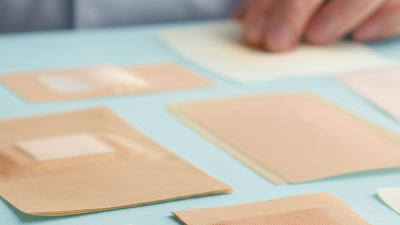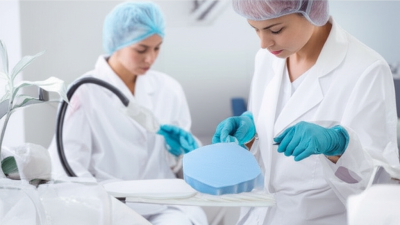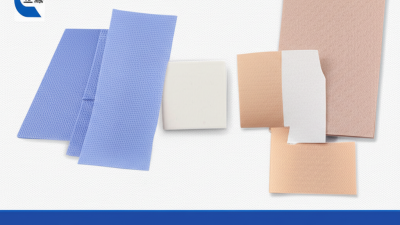How to Choose the Right Wound Dressing for Effective Healing Solutions
Choosing the right wound dressing is a critical aspect of effective healing and pain management for various types of injuries. With a multitude of options available on the market, understanding the specific characteristics and functions of different wound dressings can significantly influence the recovery process. Factors such as the type of wound, the extent of exudate, and the presence of infection all play a vital role in determining which dressing will provide the best environment for healing. This guide aims to equip you with the knowledge needed to make informed decisions when selecting wound dressings, ensuring optimal outcomes and improved patient comfort. Whether you're a healthcare professional or someone caring for a loved one, the right wound dressing can make a substantial difference in the healing journey.

Understanding Different Types of Wound Dressings and Their Applications
Choosing the right wound dressing is crucial for effective healing, and understanding the different types available can significantly impact recovery outcomes. There are several categories of wound dressings, including hydrocolloid, alginate, foam, and transparent films, each designed for specific wound conditions. For instance, hydrocolloid dressings are suitable for shallow, mildly exuding wounds, as they create a moist environment that promotes healing. In contrast, alginate dressings are ideal for heavily exuding wounds, absorbing excess moisture while providing a barrier against pathogens.
**Tip:** Always assess the wound’s characteristics, such as the level of exudate, size, and presence of infection, before selecting a dressing. Consider using foam dressings for pressure ulcers due to their cushioning properties, which protect the wound from further trauma. Transparent film dressings, on the other hand, are perfect for dry or minimally exuding wounds, allowing for easy monitoring while keeping the wound moist.
**Tip:** In addition to the type of dressing, pay attention to the duration for which the dressing can be safely left in place. Some advanced dressings can remain on for several days, providing continuous protection and comfort. Always consult healthcare professionals if there is any uncertainty about which dressing is best for your specific needs.
Evaluating Moisture Control: The Key to Promoting Wound Healing
When it comes to wound care, moisture control plays a pivotal role in promoting effective healing. According to the World Health Organization, maintaining an optimal moisture balance can significantly reduce healing time and minimize the risk of infection. In fact, studies have shown that moist wound environments can accelerate healing by up to 50% compared to dry dressings. This makes it essential for healthcare professionals and caregivers to choose wound dressings that provide the right level of moisture retention, preventing the wound from drying out while also managing exudate effectively.
Tips for evaluating moisture control in wound dressings include observing the wound exudate levels regularly and selecting dressings designed for the specific wound type. For example, hydrocolloid and foam dressings are known for their moisture-retentive properties and can help keep the wound hydrated. It's also crucial to consider the dressing's ability to allow for gaseous exchange while maintaining a damp environment. Remember that over-saturation can lead to maceration, so choosing a dressing that balances moisture management is key to successful wound healing.
Additionally, recent reports indicate that the incidence of chronic wounds is on the rise, with nearly 6.7 million patients affected in the United States alone. Recognizing the importance of moisture control in wound care can help address this growing concern and improve patient outcomes. By focusing on the right dressings, healthcare professionals can facilitate quicker recovery times and enhance the overall quality of care.
Assessing the Role of Antimicrobial Dressings in Infection Prevention
Antimicrobial dressings play a crucial role in infection prevention and are essential in modern wound care strategies. According to a report by the World Health Organization, nearly 50% of all surgical patients experience some form of wound infection, highlighting the urgent need for effective solutions. Antimicrobial dressings, which are impregnated with agents like silver, iodine, or honey, have been shown to significantly reduce microbial colonization in chronic wounds. A study published in the Journal of Hospital Infection noted that these dressings decreased infection rates by up to 70% compared to standard dressings.
Furthermore, the type of antimicrobial agent used can affect the healing process. For instance, a clinical trial published in the American Journal of Surgery found that silver-impregnated dressings not only reduced infection but also promoted faster granulation tissue formation. This dual action underscores the importance of selecting the right antimicrobial dressing based on specific wound characteristics, patient needs, and the presence of comorbidities. When considering options in wound management, healthcare professionals must prioritize dressings that utilize evidence-based antimicrobial strategies to provide optimal care and enhance healing outcomes.
Considering Patient Comfort and Compliance in Wound Dressing Selection
When selecting the appropriate wound dressing, patient comfort and compliance play crucial roles in the healing process. Comfort can be influenced by the materials used in the dressing, the size and shape, and even the method of application. Dressings that minimize pain during application and removal can significantly enhance a patient's overall experience. Materials that offer soft, breathable, and moisture-controlling properties tend to be more accepted by patients, leading to better adherence to treatment protocols.
Compliance is closely tied to how well patients tolerate wearing a dressing and how easy it is for them to manage. This includes not only comfort but also the dressing's ability to stay in place during everyday activities. Clinicians should consider the patient's lifestyle and activity level when recommending wound dressings. Providing options that are easy to change, require minimal interference in daily routines, and effectively protect the wound can improve adherence to treatment plans. Ultimately, prioritizing patient comfort and compliance when choosing a dressing fosters a more successful healing journey.
Analyzing Cost-Effectiveness of Advanced Dressings in Clinical Settings
The choice of wound dressing in clinical settings increasingly leans toward advanced options that promise not only improved healing outcomes but also cost-effectiveness. Traditional dressings, while simpler, often lack the moisture-retentive properties that facilitate a conducive healing environment. In contrast, advanced dressings such as hydrocolloids, alginates, and foam dressings provide specialized features that minimize infection risks and reduce healing time. Analyzing their cost-effectiveness involves looking beyond the initial purchase price to consider long-term benefits, including reduced medical visits, lower infection rates, and overall faster recovery, which can lead to significant savings.
In addition, the application of advanced dressings can streamline healthcare practices, reducing the need for frequent dressing changes and enabling more efficient resource allocation in clinical settings. Healthcare providers increasingly recognize that opting for more sophisticated wound care solutions can enhance patient satisfaction and outcomes. Evaluating the cost-effectiveness of these advanced dressings thus requires a comprehensive approach that factors in both direct costs and the broader implications for patient care and recovery efficiency. This analysis is essential for informed decision-making in wound management protocols, ensuring that the chosen dressing not only meets the healing needs but also aligns with budgetary considerations in healthcare facilities.
Cost-Effectiveness of Advanced Wound Dressings in Clinical Settings
This chart illustrates the cost per dressing for various types of advanced wound dressings used in clinical settings. Understanding the financial aspect of these materials is essential for making informed decisions about wound care management.
Related Posts
-

Unlocking Global Opportunities in Wound Care Management at the 137th Canton Fair 2025
-

Chinese Excellence in Wound Care Dressings: The Global Export Leader You Can Trust
-

Global Buyers Discover New Wound Care Supply Innovations at Guangzhou Trade Fair 2025
-

Top 10 Wound Care Supply Manufacturers from China at the 137th Canton Fair
-

2025 Innovations in Wound Care Management: Unveiling Effective Strategies for Global Buyers
-

Ultimate Checklist for Choosing the Best Wound Cleanser for Your Medical Supply Needs
